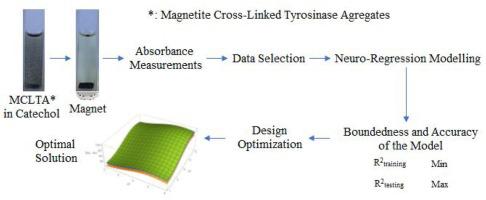当前位置:
X-MOL 学术
›
Process Biochem.
›
论文详情
Our official English website, www.x-mol.net, welcomes your
feedback! (Note: you will need to create a separate account there.)
A New Design Strategy with Stochastic Optimization on The Preparation of Magnetite Cross-Linked Tyrosinase Aggregates (MCLTA)
Process Biochemistry ( IF 3.7 ) Pub Date : 2020-12-01 , DOI: 10.1016/j.procbio.2020.08.019 İlker Polatoğlu , Levent Aydin
Process Biochemistry ( IF 3.7 ) Pub Date : 2020-12-01 , DOI: 10.1016/j.procbio.2020.08.019 İlker Polatoğlu , Levent Aydin

|
Abstract In this study, a new design strategy with a systematic optimization process is proposed for the preparation of magnetite cross-linked tyrosinase aggregates (MCLTA) by using the concentration of magnetite nanoparticle, glutaraldehyde and tyrosinase enzyme as design variables. A comprehensive study on multiple non-linear neuro-regression analysis has been performed as a compelling alternative to the insufficient approaches on modeling-design-optimization of MCLTA. For this aim, the experimental process has been modeled with 13 candidate functional structures by using a hybrid method to test the accuracy of their predictions. R2training, R2testing values, and boundedness of the functions have been checked to reveal the realistic ones. Then four different design approaches in terms of three distinct scenarios have been used to optimize the process. The results show that, all models define the process well, depending on R2training. However, only five and nine models are appropriate based on R2testing for the first use activity and residual activity, respectively. On the other hand, depending on to be a realistic value, model TON best describes the "first use activity," while the best one is FONT for residual activity. It is also concluded that the scenario types and selection of constraints for design variables affect the optimization results.
中文翻译:

一种用于制备磁铁矿交联酪氨酸酶聚集体 (MCLTA) 的随机优化新设计策略
摘要 在本研究中,以磁铁矿纳米颗粒、戊二醛和酪氨酸酶的浓度为设计变量,提出了一种具有系统优化过程的新设计策略,用于制备磁铁矿交联酪氨酸酶聚集体(MCLTA)。已对多重非线性神经回归分析进行了全面研究,作为对 MCLTA 建模-设计-优化方法不足的一种引人注目的替代方法。为此,通过使用混合方法对 13 个候选功能结构进行建模,以测试其预测的准确性。已经检查了 R2training、R2testing 值和函数的有界性,以揭示实际情况。然后根据三种不同的场景使用四种不同的设计方法来优化流程。结果表明,所有模型都很好地定义了过程,这取决于 R2training。然而,基于 R2 测试的首次使用活性和剩余活性分别只有五个和九个模型是合适的。另一方面,根据实际值,模型 TON 最好地描述了“第一次使用活动”,而最好的描述是剩余活动的 FONT。还得出结论,场景类型和设计变量约束的选择会影响优化结果。另一方面,根据实际值,模型 TON 最好地描述了“第一次使用活动”,而最好的描述是剩余活动的 FONT。还得出结论,场景类型和设计变量约束的选择会影响优化结果。另一方面,根据实际值,模型 TON 最好地描述了“第一次使用活动”,而最好的描述是剩余活动的 FONT。还得出结论,场景类型和设计变量约束的选择会影响优化结果。
更新日期:2020-12-01
中文翻译:

一种用于制备磁铁矿交联酪氨酸酶聚集体 (MCLTA) 的随机优化新设计策略
摘要 在本研究中,以磁铁矿纳米颗粒、戊二醛和酪氨酸酶的浓度为设计变量,提出了一种具有系统优化过程的新设计策略,用于制备磁铁矿交联酪氨酸酶聚集体(MCLTA)。已对多重非线性神经回归分析进行了全面研究,作为对 MCLTA 建模-设计-优化方法不足的一种引人注目的替代方法。为此,通过使用混合方法对 13 个候选功能结构进行建模,以测试其预测的准确性。已经检查了 R2training、R2testing 值和函数的有界性,以揭示实际情况。然后根据三种不同的场景使用四种不同的设计方法来优化流程。结果表明,所有模型都很好地定义了过程,这取决于 R2training。然而,基于 R2 测试的首次使用活性和剩余活性分别只有五个和九个模型是合适的。另一方面,根据实际值,模型 TON 最好地描述了“第一次使用活动”,而最好的描述是剩余活动的 FONT。还得出结论,场景类型和设计变量约束的选择会影响优化结果。另一方面,根据实际值,模型 TON 最好地描述了“第一次使用活动”,而最好的描述是剩余活动的 FONT。还得出结论,场景类型和设计变量约束的选择会影响优化结果。另一方面,根据实际值,模型 TON 最好地描述了“第一次使用活动”,而最好的描述是剩余活动的 FONT。还得出结论,场景类型和设计变量约束的选择会影响优化结果。









































 京公网安备 11010802027423号
京公网安备 11010802027423号